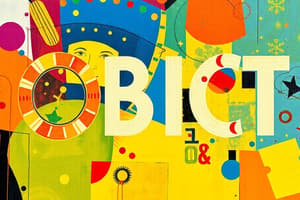Podcast
Questions and Answers
What is the primary purpose of a structure chart?
What is the primary purpose of a structure chart?
- To visualize the flow of data in a computer system
- To show the design of a system in a hierarchical format (correct)
- To provide a detailed code implementation for a program
- To outline the sequence of operations in a program
Which of the following is NOT a basic concept used in program development?
Which of the following is NOT a basic concept used in program development?
- Factorization (correct)
- Data use
- Iteration
- Selection
During which stage of the program development lifecycle is pseudocode primarily utilized?
During which stage of the program development lifecycle is pseudocode primarily utilized?
- Testing
- Analysis
- Design (correct)
- Coding
What does stepwise refinement involve in problem-solving?
What does stepwise refinement involve in problem-solving?
Which method is primarily used to represent algorithms visually?
Which method is primarily used to represent algorithms visually?
What is the purpose of pseudocode in programming?
What is the purpose of pseudocode in programming?
Which of the following accurately describes a flowchart?
Which of the following accurately describes a flowchart?
What distinguishes a variable from a constant in programming?
What distinguishes a variable from a constant in programming?
What is the benefit of using indentation and white space in programming?
What is the benefit of using indentation and white space in programming?
What does top-down design entail in computer programming?
What does top-down design entail in computer programming?
Flashcards are hidden until you start studying
Study Notes
General Programming Terms
- Program: A set of instructions that completes a specific task. Can be written in high-level or low-level languages.
- Pseudocode: Uses English words and mathematical notations to outline the steps of a program.
- Flowcharts: Uses standard symbols connected by lines to visually represent the steps of a program and their flow.
- Trace Table: Records the results of each step in an algorithm, noting changes in variable values. Used for documenting a program's "dry run".
- Tracing (Dry Run): Manually working through an algorithm step-by-step.
- Variable: A named data store that holds a value that can change during program execution.
- Constant: A named data store that holds a value that remains unchanged during program execution.
- Comments: Text blocks within pseudocode that are not executed, used to explain the code.
Maintainable Programs
- Use comments to explain the purpose of each section of code.
- Use meaningful identifiers (names) for variables, constants, arrays, procedures, and functions to clearly indicate their purpose.
- Use procedures and functions to avoid code repetition and simplify logic.
- Use indentation and whitespace to improve program readability.
Building Blocks of Programs
- Inputs: Data entered into the system.
- Processes: Tasks performed using input data and any previously stored data.
- Outputs: Information displayed or printed for users.
- Storage: Data stored in files for later use.
Design and Development
- Top-Down Design: Breaking down a computer system into sub-systems, which are then further broken down into smaller, single-action sub-systems.
- Stepwise Refinement: The process of breaking down a problem into smaller sub-systems.
- Module: An individual section of code that can be used by other programs.
- Structure Chart (or Diagram): A hierarchical diagram that shows the organization of a computer system, each level offering a more detailed breakdown. Used to provide an overview of system hierarchy and problem breakdown.
Ways to Represent Algorithms
- Flowcharts
- Pseudocode
- Structure Diagrams
Basic Programming Concepts
- Data Use: Variables, constants, and arrays.
- Sequence: The ordered steps in a task.
- Selection: Choosing a path through a program.
- Iteration: Repeating a sequence of program steps.
- Operator Use: Arithmetic operators for calculations and logical and boolean operators for decision making.
Program Development Lifecycle
- Analysis: Identifying the problem and requirements. This may involve breaking down the problem into smaller parts and abstracting (removing unnecessary details).
- Design: Using flowcharts and pseudocode to solve the problem, and using structure diagrams to decompose the problem into smaller parts.
- Coding: Writing program code (using a programming language). Early testing may be included during this stage.
- Testing: Using test data to test the program code.
Tasks During Specific Development Stages
- Analysis:*
- Abstraction: Simplifying the problem by selecting relevant elements and filtering out irrelevant details.
- Decomposition: Breaking down a complex problem into smaller, easier-to-solve parts.
- Requirement Specification: Identifying the problem and defining the program's requirements.
- Design:*
- Decomposition: Breaking down the problem into smaller sub-systems.
- Structure Diagrams: Designing the program's structure and relationships between components.
- Flowcharts: Visualizing the program's logic.
- Pseudocode: Writing out the program's steps in a structured, English-like language.
- Coding:*
- Writing Program Code: Writing the program using a chosen programming language.
- Iterative Testing: Testing each sub-system of the program, correcting errors, and repeating the process until the sub-system works as intended.
- Testing:*
- Testing Program Code: Running the completed program or programs with various sets of test data.
- Testing Definition: Running a program repeatedly with different test data to ensure all components function as intended and work together as designed.
Operators
- Operator: A special character or word that indicates a specific action to be performed in programming.
- Arithmetic Operators: Used to perform calculations (e.g., +, -, *, /).
- Logical Operators: Used to determine if an expression is true or false (e.g., AND, OR, NOT).
- Boolean Operators: Used in conjunction with logical operators to build more complex expressions. This is useful for creating more complex conditions in code for decision making.
Studying That Suits You
Use AI to generate personalized quizzes and flashcards to suit your learning preferences.




